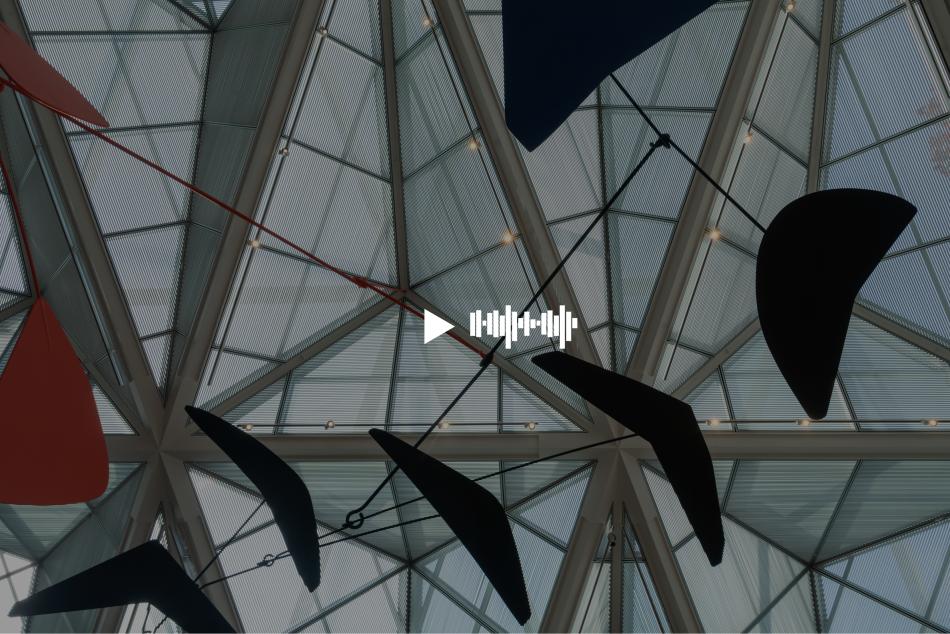Death and the Miser by Hieronymus Bosch, painted around 1485 to 1490. Oil on panel. The painted surface is about 3 feet high by 1 foot wide.
This description is about 5 minutes long.
In a bedroom, a white man – the miser – sits up in bed looking towards our left, where a skeletal figure of Death appears at the door. An angel kneels on the bed behind the man. In the foreground, another man – presumably the miser in earlier days – stows money away in a wooden chest at the foot of the bed. Little demons – with mainly human forms but grotesque, animal-like faces – peep out from hiding spots over and under the furniture.
We’ll focus first on the miser in the bed and his surroundings. Then we’ll move on to the figure of Death. And, finally, we’ll look at the man and objects in the foreground.
The bed and projecting canopy take up the right two-thirds of the composition; and the miser, sitting up in the bed, is positioned just above the midpoint of this narrow painting. The man’s face is turned in profile to our left, his skin ashen white. He has a sharp nose and his head is covered by a black skullcap. A dusty rose-colored bedspread is pulled up to his waist. From the waist up, it’s hard to tell if his thin body is naked or if he wears a close-fitting light-colored nightgown.
He sits back against a grayish pillow, which spans the width of the bed. The bedhead is framed by a terracotta pink canopy with matching curtains, which hang down to each side.
Kneeling immediately behind the miser, to our right, is a winged angel in a white robe. Like the miser, he faces our left in profile, and his back is partially concealed by the curtain to the right. His left hand, nearest us, is placed on the miser’s shoulder. With his right arm he gestures up towards a small window. The window is set at the top left, in the vaulted ceiling of the bedroom. A statuette of Jesus on the cross hangs in the window, with a ray of light coming from it.
To the left of the bed, a demon peers from under the bedcurtain to reach up and offer the miser a bag of money. The demon has a gray, frog-like face. Above the miser’s head, a furry demon holding a lantern gazes over the edge of the bed canopy.
Now let’s turn to the figure of Death. Along the left edge of the composition, and level with the miser and kneeling angel, the skeleton appears around a half-open door. His skull turns towards the miser, mouth agape. A bone-white cloth drapes over his head and falls over his emaciated body, which is partly hidden by the door. He reaches round with his right arm to point an arrow at the miser.
Finally, let’s focus on the foreground. At the foot of the bed is a wooden chest with short legs and the lid propped open with a dagger. A man to our right leans over it, wearing an ankle length, moss green robe with a matching turban wound around his head. His nose is long and sharp, his cheeks gaunt, and his eye socket dark and hollow.
With his left hand, nearest us, he leans on a stick. With his right hand, he drops coins into a sack held open by a rat-faced demon inside the chest.
Two more demons lurk under the chest. One, to the left, holds up a piece of paper with a red seal. This demon has wings, a gaping toothy mouth, and claw-like hands and feet. The other creature, to the right, is mainly hidden by the trunk: only the reptilian hind quarters and long tail of the other demon stick out under the chest.
The space of the bedroom is separated from us by a pointed, white stone arch supported on two columns, which run parallel to the sides of the narrow painting. The columns rest on a low stone ledge in the foreground, which is draped with a petal-pink cloth and a golden-brown garment. The sixth and final demon, wearing a black, hooded cowl leans against the ledge with its head propped in one hand. A sword, helmet, gauntlet, shield, and lance are piled against our side of the ledge near the lower right corner of the painting.



